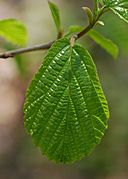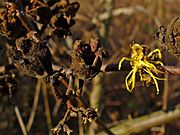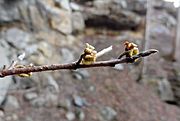Hamamelis virginiana facts for kids
Quick facts for kids Hamamelis virginiana |
|
|---|---|
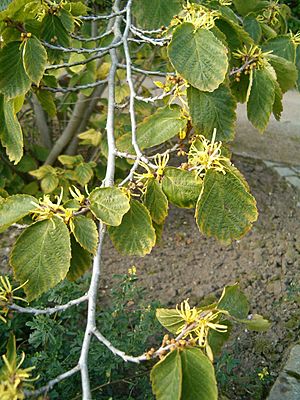 |
|
| Leaves and flowers | |
| Conservation status | |
| Scientific classification | |
| Genus: |
Hamamelis
|
| Species: |
virginiana
|
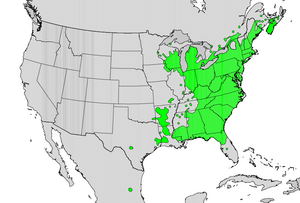 |
|
| Distribution of witch-hazel | |
Witch-hazel (scientific name: Hamamelis virginiana) is a special type of flowering shrub. It is also called common witch-hazel or American witch-hazel. This plant grows naturally in eastern North America. You can find it from Nova Scotia in Canada, west to Minnesota, and south to central Florida and eastern Texas.
Contents
Discovering the Witch-Hazel Plant
Witch-hazel is usually a small deciduous tree or a shrub. Deciduous means it loses its leaves in the fall. It can grow up to 6 meters (about 20 feet) tall. Sometimes, it can even reach 10 meters (about 33 feet)! It often has many stems growing close together from its base.
Bark and Branches
The bark of the witch-hazel is light brown and smooth. It might look a bit scaly. The inner bark has a reddish-purple color.
When the branches are young, they are a light orange-brown and feel soft. They have small white dots. As they get older, they turn a darker reddish-brown. The buds on the branches are pointed and slightly curved. They are also soft and light brown.
Leaves of the Witch-Hazel
The leaves are shaped like an oval. They are about 3.7 to 16.7 centimeters (1.5 to 6.5 inches) long. They are also about 2.5 to 13 centimeters (1 to 5 inches) wide. The bottom of the leaf is slanted, and the tip can be pointed or rounded. The edges of the leaves are wavy or have shallow lobes.
The leaf stem, called a petiole, is short and strong, about 6 to 15 millimeters (0.2 to 0.6 inches) long. The main vein in the middle of the leaf is usually a bit hairy. It has six to seven pairs of smaller veins branching off it.
When the leaves first open, they are rolled up and covered with a rusty, star-shaped fuzz. When they are fully grown, the top side is dark green, and the underside is paler. In the fall, the leaves turn bright yellow and might have rusty spots. Small leaf-like parts called stipules are at the base of the leaf. They are pointed and fall off soon after the leaf grows.
Flowers and Fruit
Witch-hazel flowers are usually pale to bright yellow. Sometimes, they can be orange or reddish. Each flower has four petals that look like ribbons, about 1 to 2 centimeters (0.4 to 0.8 inches) long. They also have four short stamens, which are the parts that make pollen. The flowers grow in clusters.
What's cool is that witch-hazel flowers bloom in the middle to late fall! This is different from many other plants. The flower's outer green part, called the calyx, has four deep sections. It is very fuzzy and orange-brown inside. It stays on the plant even after the flower blooms. There are also two or three small leaf-like parts called bractlets at the base of the flower.
The fruit of the witch-hazel is a hard, woody capsule. It is about 10 to 14 millimeters (0.4 to 0.6 inches) long. This fruit takes a whole year to ripen after the flower is pollinated. When it's ready, it splits open with a loud pop! This explosion shoots out two shiny black seeds up to 10 meters (about 33 feet) away from the parent plant.
You can tell the common witch-hazel apart from a similar plant called Hamamelis vernalis because Hamamelis virginiana flowers in the fall, not in the winter.
Witch-Hazel in Nature
The witch-hazel plant is important for many insects. It provides food for 62 different kinds of caterpillars.
Uses of Witch-Hazel
Witch-hazel has been used for a long time, especially for its helpful properties.
Traditional Uses
Native Americans were the first to discover the benefits of witch-hazel. They would boil the stems of the shrub to make a special liquid called a decoction. This liquid was used to help with swellings, inflammations (when a part of your body gets red and sore), and even tumors.
Early European settlers, like the Puritans in New England, learned about this remedy from the Native Americans. Soon, using witch-hazel became very popular across the United States.
Modern Products
Today, an extract from the witch-hazel plant is used to make a product also called witch hazel. This is a type of astringent, which means it can help tighten skin and reduce oiliness. You might find it in skin care products.
Scientists have also found that H. virginiana produces special substances called hamamelitannins. Researchers are studying some of these substances because they show interesting activity against certain types of cells.
Historically, the bark and leaves were used by Native Americans to treat skin inflammations. A well-known product called Pond's Extract was a popular liquid made from the bark mixed with a small amount of alcohol.
Other Uses
The wood of the witch-hazel tree is light reddish-brown, and its inner wood (sapwood) is almost white. It is heavy, hard, and has a close grain.
Interestingly, the forked (Y-shaped) twigs of witch-hazel are often chosen to be used as divining rods. Some people believe these rods can help find underground water.
See also
 In Spanish: Avellano de bruja para niños
In Spanish: Avellano de bruja para niños



